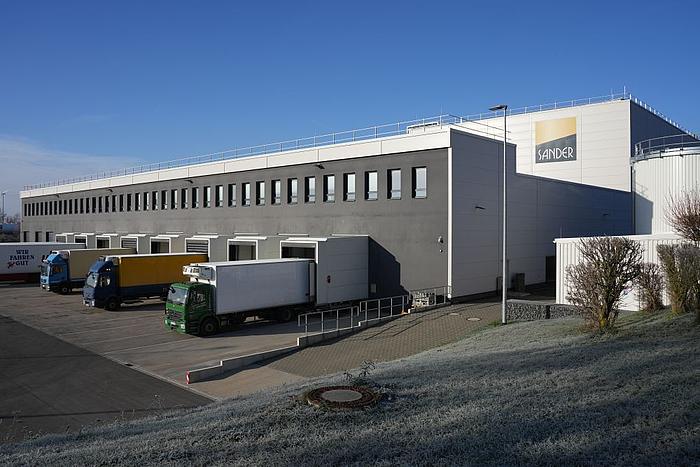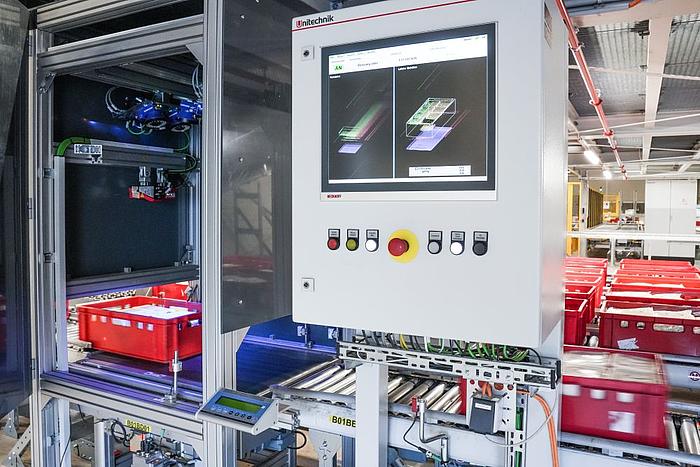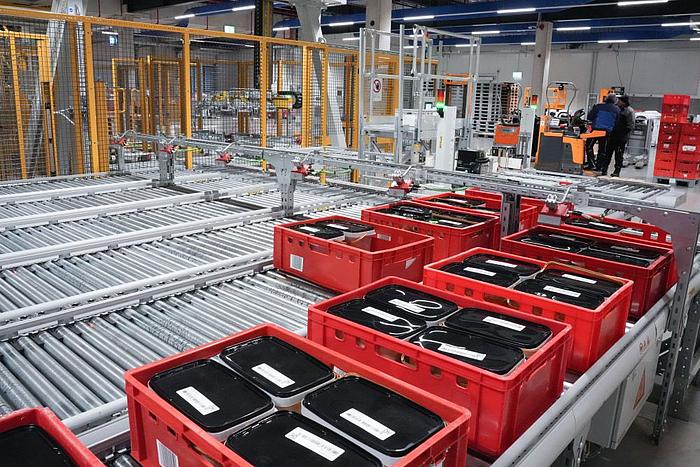Fresh food deliveries to restaurants, canteens and hotels are the area of expertise of Sander Gourmet GmbH. In order to create more flexibility in its delivery services, the full-service provider in the food service market recently built a new refrigerated logistics center at the Wiebelsheim site. For the corresponding technical expertise, Sander Gourmet relied on Unitechnik Systems GmbH - and was able to significantly increase its goods throughput as a result.
The machines shut down, the production hall is empty for half an hour: lunch break. Especially after a hard shift, the food in the canteen tastes twice as good. But where does the salmon in lemon dill sauce, the vegetable lasagna or the rosemary potatoes actually come from? Companies are often supplied with these by convenience food manufacturers such as Sander Gourmet GmbH. The company stands for high quality and product variety with its fresh food manufactory. It is part of Sander Holding GmbH & Co KG from Wiebelsheim, which has been serving countless markets in the food service sector for over 45 years. Every day, Sander Gourmet delivers more than 2,500 high-quality fresh products from 15 in-house manufacturing areas to restaurants, canteens, schools and hospitals throughout Germany. A new refrigerated logistics center was to be built at the Wiebelsheim site to handle higher shipping volumes and more storage space in the normal and deep-freeze areas.
Challenge: E2 pool boxes
A general challenge with conveyor technology in the food sector is the automatic transport of E2 containers, also known as meat boxes. These boxes usually have a long journey behind them, as they are largely used as transport containers between producers and retailers - meaning they come from a Germany-wide exchange process. If the boxes are too deformed or damaged, they can no longer be reliably transported via automated logistics systems. This is because curved bottoms can cause the totes to rotate and tilt on the conveyor system. In addition, damaged side walls can mean that sensors can no longer correctly detect the dimensions of the container and robots no longer have a defined gripping position. Until now, the solution to this situation has usually been to use trays that serve as coasters and make transport on the conveyor system safe. The disadvantage: tray handling requires additional effort, which increases costs and takes up extra space.
High level of automation for the new logistics center
In order to be able to map the logistics processes as efficiently and space-savingly as possible, Sander Gourmet wanted a solution that could do without lower trays. Despite this, a high degree of automation was to relieve the company's own employees and enable the goods to be made available in the shortest possible time in line with the order. Furthermore, due to the short best-before date of finished dishes, the warehouse had to guarantee the FeFo principle (first expire - first out). To implement these requirements, the company secured the support of Unitechnik Systems GmbH. The general contractor from Wiehl plans and implements customized systems for in-house logistics and production. In doing so, Unitechnik acts as system integrator and overall supplier and was thus also able to combine components from different suppliers for the ideal cold storage.
Unitechnik software controls error-free conveying
In order to cope with the various challenges in the new cold logistics center in the best possible way, Sander Gourmet relies on the integrated control and guidance system from Unitechnik. The heart of this is the UniWare warehouse management system. Furthermore, a special module is used in this project: the Box Geometry Check (BGC) system. Using a special sensor measurement technology from Unitechnik, this system enables the stable automated transport of the E2 containers without the use of trays. To this end, it checks each box for deformations and breakouts even before it is placed in storage. If the container is no longer conveyable, the software automatically detects this and sorts it out of the system. Each box then passes through the identification point (I-point). There, it and the goods it contains are recorded by barcode and checked for plausibility by means of a checkweighing process. Together with a photo of the contents, everything is stored in UniWare. For most containers, this process is fully automated.
All operational processes within Sander Gourmet's logistics center are coordinated by UniWare. This includes, for example, goods receipt at container or pallet level, storage, picking, order consolidation and provision at goods issue according to route planning.
The physical transports of the E2 containers on the widely branched plant are organized by UniWare-MFS, the material flow control module of Unitechnik's integrated WMS system. Plant operators can track all movements and states of the logistics system via UniWare-VISU. The system visualization is continuously zoomable and clearly displays all information - from the switching status of each sensor to the position of the E2 crates and their contents. The system interfaces with Sander's ERP system CSB to reconcile the data in real time.
Material flow is automated as far as possible
Thanks to the intelligent linking of the individual systems, the logistics center runs largely automatically: After delivery from the nearby
Sander production facilities, a robot depalletizes the E2 crates and sets them down on the container conveyor system. The H1 empty pallets are stacked and automatically transported to an acceptance point.
The E2 containers, which have passed the box geometry check, finally reach the shuttle warehouse via conveyor technology for storage. This is where article-clean, pre-picked and empty totes are stored. The shuttle warehouse supplies 488 throughput channels that form several picking stations. Using a pick-by-light system, employees pick orders where the customer only requires partial quantities of a container. Both the order totes and the remaining quantities and empty totes are returned to the shuttle warehouse. The latter are later made available again as empty target totes for order picking. Once an order has been completely picked and is called off for dispatch, all the associated totes are moved in sequence to the goods issue area. The so-called "outgoing goods harp", a sorting buffer consisting of six parallel conveyor sections and capable of holding up to 96 totes, is used to provide the orders. At the goods issue point, the containers receive their label and a gantry robot automatically stacks up to 20 containers onto the assigned pallet or grid trolley. Finally, an automated pallet wrapper secures the pallet with wrapping and cover sheet film before it is made available on the shipping area.
Robotics ensure high throughput
In order to achieve the required speed, strong workers are needed: A lot of robotics is therefore used in the new logistics center. In incoming goods, a gantry robot depalletizes up to 1,350 E2 crates per hour, while its "colleague" in outgoing goods palletizes up to 1,200 E2 crates. The downstream wrapper processes 140 pallets per hour. The core of the logistics center is the shuttle warehouse with up to 2,000 storage and retrieval operations per hour. With double-deep storage, there is space for 30,000 E2 crates. These spaces are distributed over three aisles with 40 racking levels, each with a shuttle - so a total of 120 vehicles whiz through the warehouse cube and store and retrieve goods.
Cooperation increases performance in the new logistics center
"For Unitechnik, the project was a challenge that we gladly accepted," says Andre-Pierre Becker, responsible project manager on the part of Unitechnik. "We were able to use our experience from similar projects expediently at Sander Gourmet. We know the classic problems and were therefore able to offer the perfect solution approach for the stable transport of E2 crates without the use of trays with the BGC system."
Lars Laskowski, Business Unit Manager Procurement, Production & Logistics at Sander Gourmet, also sees the cooperation as a complete success: "With the automation of the new logistics center, we wanted above all to relieve our employees. Previously, they had to move the goods by hand or with pallet trucks - that is now history. In addition, our material flow has accelerated significantly and we can avoid waiting times with the outgoing goods harp. Thanks to the automatic conveyor system, we achieve a very high throughput of goods with a minimal error rate."






